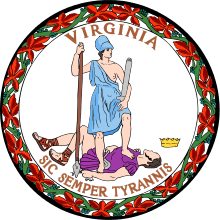William M. Tuck
| William M. Tuck | |
|---|---|
 | |
| Member of the U.S. House of Representatives from Virginia's 5th district | |
| In office April 14, 1953 – January 3, 1969 | |
| Preceded by | Thomas B. Stanley |
| Succeeded by | Dan Daniel |
| 55th Governor of Virginia | |
| In office January 16, 1946 – January 18, 1950 | |
| Lieutenant | Lewis Preston Collins II |
| Preceded by | Colgate Darden |
| Succeeded by | John S. Battle |
| 25th Lieutenant Governor of Virginia | |
| In office 1942–1946 | |
| Governor | Colgate Darden |
| Preceded by | Saxon Winston Holt |
| Succeeded by | Lewis Preston Collins II |
| Member of the Virginia Senate from Halifax County | |
| In office 1932–1942 | |
| Preceded by | James Stone Easley |
| Succeeded by | James Hagood |
| Member of the Virginia House of Delegates from Halifax County | |
| In office 1924 – 1932 Alongside John Glass, Samuel Adams and A. Owen King | |
| Personal details | |
| Born | September 28, 1896 Halifax County, Virginia |
| Died | June 9, 1983 (aged 86) South Boston, Virginia |
| Resting place | Oak Ridge Cemetery, South Boston, Virginia |
| Nationality | United States |
| Political party | Democratic |
| Spouse(s) | Eva Ellis Lovelace Dillard Tuck |
| Alma mater | College of William and Mary Washington and Lee University |
| Profession | Attorney |
| Military service | |
| Service/branch | United States Marine Corps |
| Years of service | 1918–1919 |
| Battles/wars | World War I |
William Munford Tuck (September 28, 1896 – June 9, 1983) served as the 55th Governor of Virginia from 1946 to 1950 as a Democrat.
Biography
He was the youngest son of Halifax County, Virginia tobacco warehouseman Robert James Tuck and Virginia Susan Fritts. Tuck graduated from the College of William and Mary, earning a teacher's certificate. He served in U.S. Marine Corps in 1917 in the Caribbean. He graduated from Washington and Lee University School of Law in 1921 and was admitted to Virginia bar then was a Halifax, Virginia attorney who also served in both houses of the Virginia General Assembly and as the 25th Lieutenant Governor of Virginia from 1942 to 1946. As governor, he reorganized state government, enacted a right-to-work law, and created a state water pollution control agency.
Tuck was elected as a Democrat to U.S. Congress seat in 1953 to assume vacancy created by Thomas Bahnson Stanley who had resigned to run for Governor of Virginia. There he opposed most major items of civil rights legislation during the 1950s and 1960s. He also promised "massive resistance" to the Supreme Court's 1954 decision banning segregation, Brown v. Board of Education, and helped draft the Stanley plan—a series of state laws designed to legally avoid Brown.
He is buried in Oak Ridge Cemetery, South Boston, Virginia.
He was a delegate to Democratic National Conventions of 1948 and 1952.
His personal papers, including papers from his time as congressman and governor, are held by the Special Collections Research Center at the College of William & Mary.[1] His executive papers from his time as governor are held by the Library of Virginia.
His birthplace and home Buckshoal Farm was listed on the National Register of Historic Places in 1987.[2][3]
Electoral history
- 1945; Tuck was elected Governor of Virginia with 66.57% of the vote, defeating Republican Sidney Floyd Landreth and Independent Howard Hearness Carwile.
- 1953; Tuck was elected to the U.S. House of Representatives with 57.81% of the vote in a special election, defeating Republican Lorne R. Campbell.
- 1954; Tuck was re-elected unopposed.
- 1956; Tuck was re-elected unopposed.
- 1958; Tuck was re-elected unopposed.
- 1960; Tuck was re-elected unopposed.
- 1962; Tuck was re-elected unopposed.
- 1964; Tuck was re-elected with 63.47% of the vote, defeating Republican Robert L. Gilliam.
- 1966; Tuck was re-elected with 56.18% of the vote, defeating Republican Gilliam.
References
- ↑ "William Munford Tuck Papers". Special Collections Research Center, Earl Gregg Swem Library, College of William and Mary. Retrieved February 1, 2011.
- ↑ "National Register Information System". National Register of Historic Places. National Park Service. 2010-07-09.
- ↑ Virginia Historic Landmarks Commission (June 1978). "National Register of Historic Places Inventory/Nomination: Buckshoal Farm" (PDF). Virginia Department of Historic Resources.
- "TUCK, William Munford, (1896–1983)", Biographical Directory of the United States Congress
- "TUCK, Governor William Munford", South Boston Halifax County Museum of Fine Arts and History
- "Gov. & Mrs. William M. Tuck". Historical Sketches, 1884–1984. Halifax County, Virginia: South Boston Steering Committee, OldHalifax.com. Retrieved November 10, 2008.
External links
| Political offices | ||
|---|---|---|
| Preceded by Colgate Darden |
Governor of Virginia 1946–1950 |
Succeeded by John S. Battle |
| Preceded by Saxon Winston Holt |
Lieutenant Governor of Virginia 1942–1946 |
Succeeded by Lewis Preston Collins II |
| United States House of Representatives | ||
| Preceded by Thomas B. Stanley |
Member of the U.S. House of Representatives from Virginia's 5th congressional district 1953–1969 |
Succeeded by W. C. "Dan" Daniel |
| ||||||||
|
